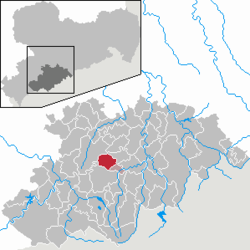Geyer
| Geyer | ||
|---|---|---|
 |
||
|
||
| Coordinates: 50°37′25″N 12°55′24″E / 50.62361°N 12.92333°ECoordinates: 50°37′25″N 12°55′24″E / 50.62361°N 12.92333°E | ||
| Country | Germany | |
| State | Saxony | |
| District | Erzgebirgskreis | |
| Municipal assoc. | Geyer | |
| Government | ||
| • Mayor | Harald Wendler (Die Linke) | |
| Area | ||
| • Total | 18.76 km2 (7.24 sq mi) | |
| Elevation | 550-741 m (−1,881 ft) | |
| Population (2015-12-31) | ||
| • Total | 3,582 | |
| • Density | 190/km2 (490/sq mi) | |
| Time zone | CET/CEST (UTC+1/+2) | |
| Postal codes | 09468 | |
| Dialling codes | 037346 | |
| Vehicle registration | ERZ | |
| Website | www.stadt-geyer.de | |
Geyer is a town in the district of Erzgebirgskreis, in Saxony, Germany. It has a population of about 4000.
Geyer is situated 8 km (4.97 mi) northwest of Annaberg-Buchholz, and 23 km (14.29 mi) south of Chemnitz, in the valley of the Geyersbach creek. The town is largely surrounded by forest, with the Geyersche Wald forest to the west being owned by the town.
Geyer borders to Ehrenfriedersdorf in the north east, Tannenberg in the south east, Elterlein in the south. The town of Zwönitz is in the west, Hormersdorf to the north west and the Greifensteine area to the north.
Geyer was first mentioned in official documents in 1381, although mining in the Erzgebirge area had already existed a few decades before. In 1407 Geyer was granted town privileges (Marktrecht), and 60 years later it already became a town. In 1537 the town was introduced to the Protestant Reformation. Famous Renaissance builder Hieronymus Lotter settled in Geyer in 1566.
In the 16th century mining became harder to sustain, since most of the mines started to become depleted, which produced more and more waste rock. This resulted in larger and larger cavities, which led in 1704 and in 1803 to large cave-ins in Geyer. The resulting Geyersche Binge cave-in can still be visited today.
With the decline in ore-mining in the area, Geyer (as in many other towns and villages in the Erzgebirge) turned to wooden toy manufacture - such as Schwibbogen, nutcrackers and Christmas pyramids - as well as "klöppeln" as a matter of economic survival. In the 18th and 19th centuries, the textile industry was the main source of income for Geyer. In 1888, Geyer was connected to a narrow gauge railway that was to become part of the Thumer Netz, and in 1897, the town was connected to the electrical grid.
...
Wikipedia



